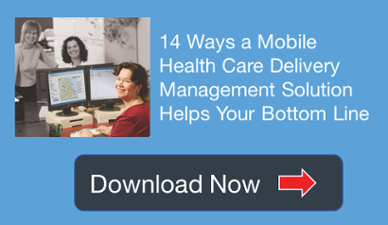Effective communication is always important in the home care industry. But when it comes to remote workers, who likely spend a lot of time in the homes of clients but very little time in the office, a solid communication plan becomes essential.
 This requires some thought. Not only do you need to keep your home care workers up to speed on agency-related information, you also need to keep them informed on care plans, schedules, and other client-specific details. And yet, when communicating any sensitive personal health information, agencies must be mindful of HIPAA compliance, data ownership, and security.
This requires some thought. Not only do you need to keep your home care workers up to speed on agency-related information, you also need to keep them informed on care plans, schedules, and other client-specific details. And yet, when communicating any sensitive personal health information, agencies must be mindful of HIPAA compliance, data ownership, and security.
In the face of these logistical challenges when trying to connect remote workers, it’s easy to let communication suffer. But it doesn’t have to. Let’s look at eight ways you can improve communication with the remote home care workers in your agency.
1. Schedule Routine Conference or Video Calls
Regularly scheduled meetings help build rapport and accountability with team members. Consistent feedback can also help your staff’s professional development. Use these calls to set priorities, establish long- and short-term goals, talk about challenges they experience in the field, and bond as a team.
To be successful, teams must spend time together; if bringing everyone physically together into the office isn’t practical, these calls are the next best thing. And if you need more time to speak with individual team members, schedule one-on-one calls to build even deeper relationships and foster improved work.
2. Set Communication Response Expectations
Make sure your employees know how and when you expect them to communicate. How quickly do you expect them to answer important messages? Must they be reachable during certain hours each day?
When setting expectations, remember to account for different time zones (if applicable) and the varied work schedules each employee has.
3. Be Transparent
Giving all employees the same access to business-critical information and processes not only helps keep everyone informed, it can improve your workers’ understanding of your business and the value they add to your agency.
When your employees know what the team is working on in the office — and what weekly, quarterly, and yearly goals they’re working toward — they better understand how their work contributes to the success of your organization, increasing trust and loyalty.
4. Keep the Lines of Communication Open
Your employees should feel like they can always come to you with questions, concerns, and requests for feedback. Employees who are comfortable talking with management about problems will feel like a valued part of the care team, and management will have the opportunity to efficiently and proactively address issues before they become full-fledged problems.
5. Use Secure Broadcast Messaging
When agency staff need to quickly communicate with caregivers, secure broadcast messaging with tracking makes it easy to globally communicate emergency messages and critical information like inclement weather notifications, flu shot clinics, and CPR certification classes.
6. Be Proactive
From care plan updates to scheduled days off, let staff know about changes to their schedules and workload in a timely manner. Giving them as much notice as possible helps them plan accordingly, ensures nothing falls through the cracks, and keeps care as the priority.
7. Keep Communication in One Place
It’s easy for conversations to get lost if you’re using multiple methods of electronic communication with your team. Establish a preferred communication channel, such as secure messaging through a mobile application, to increase efficiency and compliance while minimizing confusion.
8. Communicate Effectively and Concisely
Text messages are a convenient way to send quick business-related messages, but it’s important to recognize that texts aren’t necessarily the best way to exchange complicated, sensitive health information, like significant changes to a patient’s care. A secure message through your mobile application is a more effective way to communicate this type of information. Additionally, the messages are automatically stored and saves money by eliminating the need for a separate application.
Keeping connected with your remote home care workers is important; ensuring that communication meets evolving compliance requirements is essential. By improving the way you communicate with staff, your agency can experience streamlined operations, real-time decision making, and seamless coordination between office staff and remote workers.
If you want to learn more about improving the communication between your caregivers and your agency, contact CellTrak today. Our Care Delivery Management solution helps you comply with HIPAA requirements, foster real-time communication, and improve client outcomes.
